Attached files
| file | filename |
|---|---|
| EX-99.1 - EX-99.1 - NABORS INDUSTRIES LTD | a18-7151_1ex99d1.htm |
| 8-K - 8-K - NABORS INDUSTRIES LTD | a18-7151_18k.htm |
4Q17 Earnings Presentation February 27, 2018 Presented by: Anthony G. Petrello Chairman, President, & Chief Executive Officer William J. Restrepo Chief Financial Officer
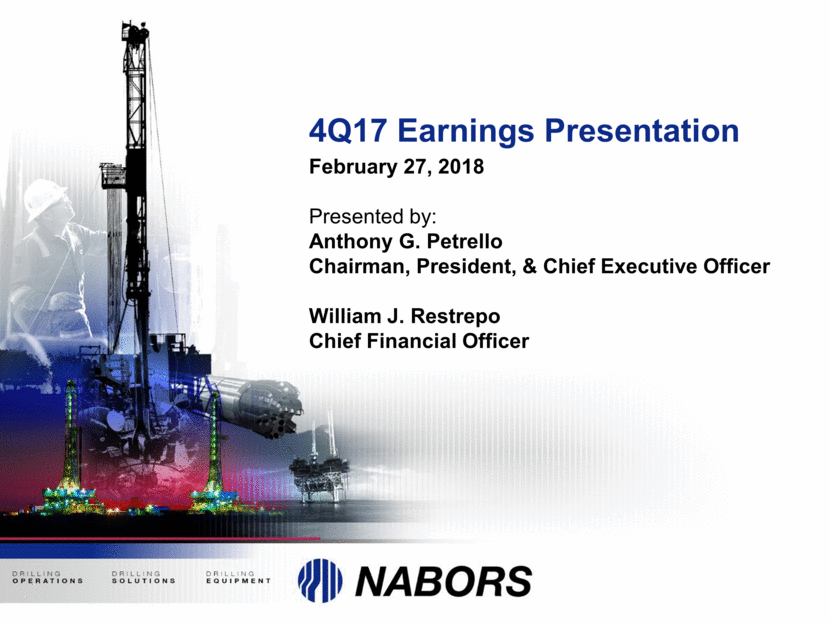
2 We often discuss expectations regarding our future markets, demand for our products and services, and our performance in our annual, quarterly, and current reports, press releases, and other written and oral statements. Such statements, including statements in this document that relate to matters that are not historical facts, are “forward-looking statements” within the meaning of the safe harbor provisions of Section 27A of the U.S. Securities Act of 1933, as amended and Section 21E of the U.S. Securities Exchange Act of 1934, as amended. These “forward-looking statements” are based on our analysis of currently available competitive, financial and economic data and our operating plans. They are inherently uncertain, and investors should recognize that events and actual results could turn out to be significantly different from our expectations. Factors to consider when evaluating these forward-looking statements include, but are not limited to: fluctuations and volatility in worldwide prices of and demand for natural gas and oil; fluctuations in levels of natural gas and oil exploration and development activities; fluctuations in the demand for our services; competitive and technological changes and other developments in the oil and gas and oilfield services industries; our ability to renew customer contracts in in order to maintain competitiveness; the existence of operating risks inherent in the oil and gas and oilfield services industries; the possibility of the loss of one or a number of our large customers; the impact of long-term indebtedness and other financial commitments on our financial and operating flexibility; our access to and the cost of capital, including the impact of a downgrade in our credit rating, availability under our unsecured revolving credit facility, and future issuances of debt or equity securities; our dependence on our operating subsidiaries and investments to meet our financial obligations; our ability to retain skilled employees; our ability to complete, and realize the expected benefits of, strategic transactions, including our announced joint venture in Saudi Arabia and the transaction with Tesco Corporation; the possibility of changes in tax laws and other laws and regulations; the possibility of political or economic instability, civil disturbance, war or acts of terrorism in any of the countries in which we do business; and general economic conditions, including the capital and credit markets. Forward-Looking Statements and Non-GAAP Financial Measures
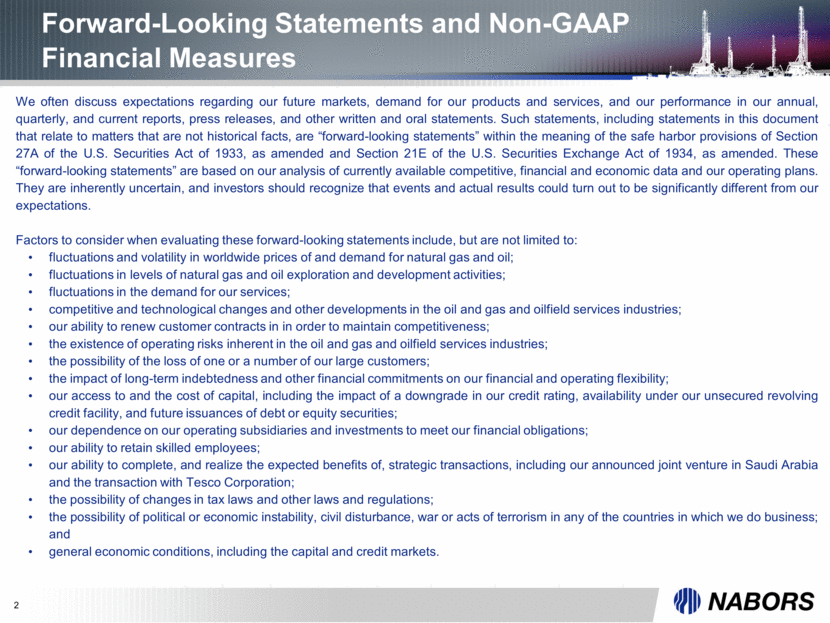
3 Our businesses depend, to a large degree, on the level of spending by oil and gas companies for exploration, development and production activities. Therefore, sustained lower oil or natural gas prices that have a material impact on exploration, development or production activities could also materially affect our financial position, results of operations and cash flows. The above description of risks and uncertainties is by no means all-inclusive, but is designed to highlight what we believe are important factors to consider. For a discussion of these factors and other risks and uncertainties, please refer to our filings with the Securities and Exchange Commission ("SEC"), including those contained in our Annual Reports on Form 10-K and Quarterly Reports on Form 10-Q, which are available at the SEC's website at www.sec.gov. Non-GAAP Financial Measures This presentation refers to certain “non-GAAP” financial measures, such as adjusted EBITDA, adjusted operating income (loss) and net debt. The components of these non-GAAP measures are computed by using amounts that are determined in accordance with accounting principles generally accepted in the United States of America (“GAAP”). A reconciliation of adjusted EBITDA and adjusted operating income (loss) to income (loss) from continuing operations before income taxes and net debt to total debt, which are their nearest comparable GAAP financial measures, is provided in the Appendix at the end of this presentation. Forward-Looking Statements and Non-GAAP Financial Measures
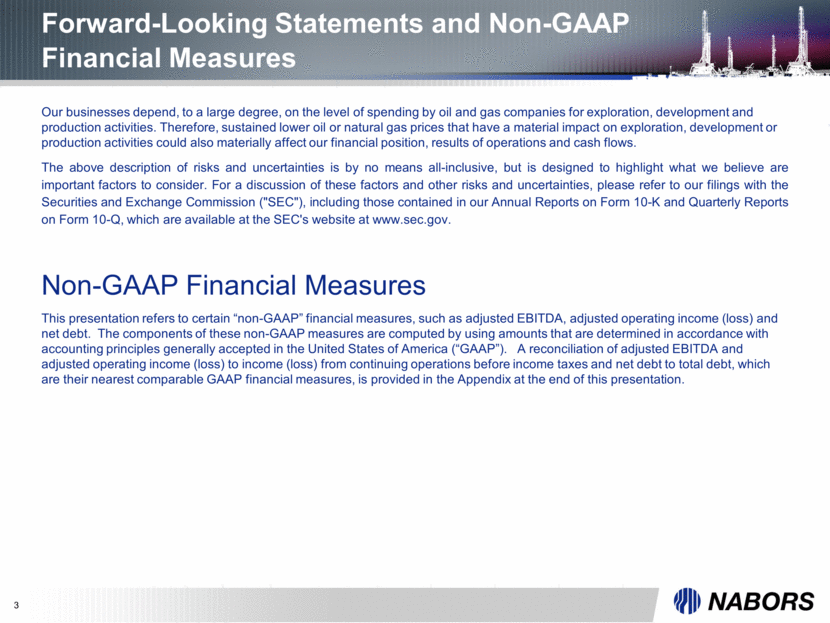
4 Recent Company Highlights Closed acquisition of Tesco Corporation in ~$180mm all-stock transaction (Dec 15, 2017) Commenced operations on SANAD joint venture with Saudi Aramco (Dec 1, 2017) Acquired Robotic Drilling Systems AS ("RDS") in September, a provider of automated tubular and tool handling equipment for the onshore and offshore drilling markets Increased U.S. segment average daily margins to $6,444 from $5,296 in the previous quarter Currently operating 107 rigs in the Lower 48 with the PACE®-X, PACE®-M800, and PACE®-M1000 rigs fully utilized, versus 101 average in Q4 Increased Nabors Drilling Solutions Adjusted EBITDA by 29% sequentially and achieved $50MM annual run-rate target Poised to begin MODS™ M-400 Rig (Big Foot) operations no later than April 1, 2018 Margin equivalent of approximately 20 onshore rigs
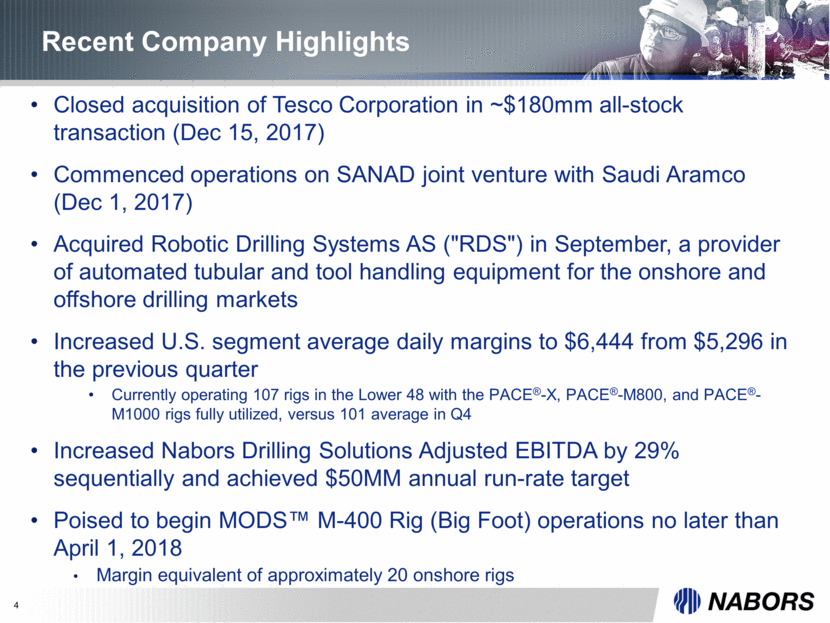
5 Financial Overview
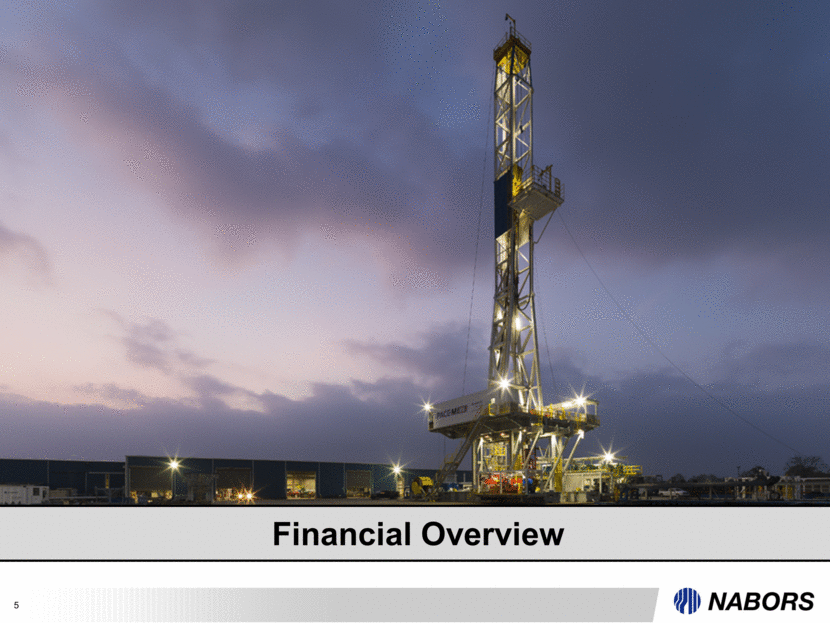
6 Financial Summary See reconciliations in the Appendix Diluted Earnings (Losses) Per Share from continuing operations Includes impairments of $0.87 per share related to the impairment of certain assets and other charges ($000 except EPS) 4Q16 1Q17 2Q17 3Q17 4Q17 Operating Revenues $538,948 $562,550 $631,355 $662,103 $708,277 Adjusted EBITDA(1) 146,021 99,740 138,796 142,870 162,557 Adjusted Operating(1) Income (Loss) (70,166) (103,932) (69,294) (74,205) (51,549) GAAP Diluted EPS(2) (1.17)(3) (0.52) (0.41) (0.42) (0.40)
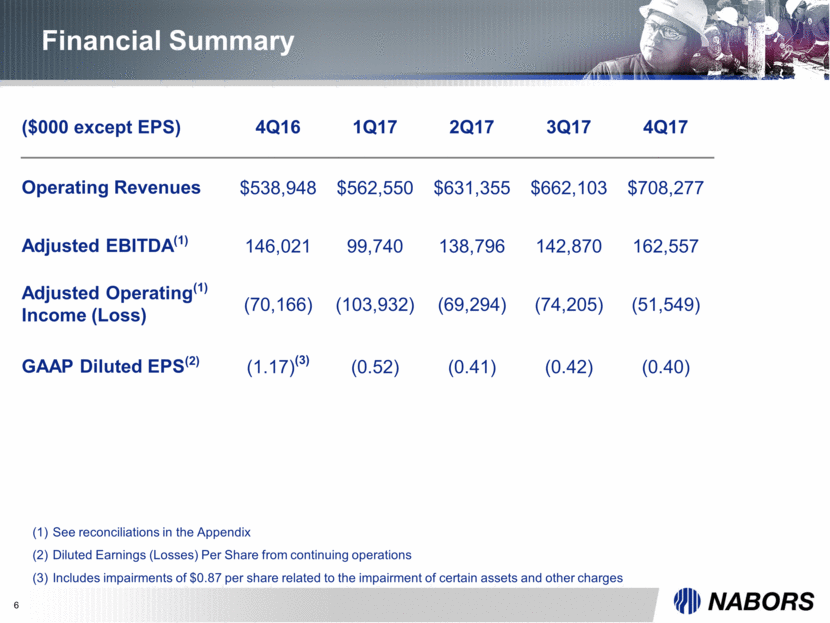
Current Debt and Liquidity (As of December 31, 2017) (1) See reconciliations in the Appendix (2) Capitalization defined as Net Debt plus Shareholders’ Equity (3) Coverage defined as TTM Adjusted EBITDA / TTM Interest Expense (4) Leverage defined as Net Debt / TTM Adjusted EBITDA Note: Subtotals may not foot due to rounding Liquidity (at December 31, 2017) Cash & Available Capacity: $2,065 High 4Q16 3Q17 4Q17 Change ($MM's) 3/31/12 12/31/16 9/30/17 12/31/17 4Q17 from 3Q17 Total Debt $4,750 $3,579 $3,959 $4,028 $69 Cash and ST Investments 494 295 220 365 145 Net Debt(1) $4,256 $3,283 $3,738 $3,663 ($76) Shareholders’ Equity 5,811 3,247 2,901 2,912 10 Net Debt to Capitalization(2) 42% 50% 56% 56% (1%) Coverage(3) 7.8x 3.4x 2.5x 2.4x 0.0x Leverage(4) 2.2x 5.3x 7.1x 6.7x (0.4x)
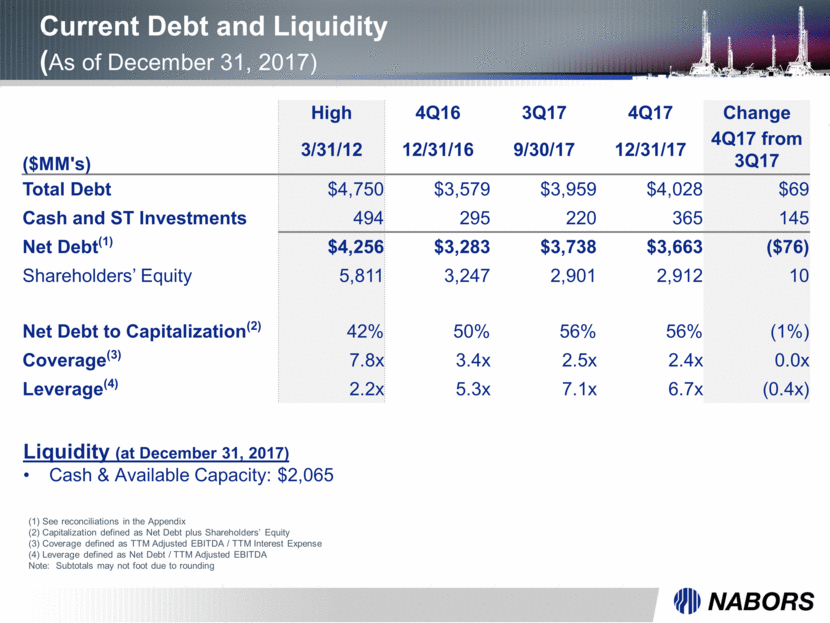
8 Business Segments

Rig Fleet(1) 4Q17 Average Rigs Working Average Utilization U.S. Lower 48 AC > 1500HP 114 88 77% AC Others 72 10 14% SCR Rigs 24 3 13% U.S. Lower 48 Total 210 101 48% U.S. Offshore 14 2 17% Alaska 16 3 19% Canada 42 14 33% International 163 91 56% Subtotal 445 211 47% PACE®-R800 Rig Construction 1 PACE®-M1000 Rig Construction 2 Total Fleet 448 9 4Q17 Rig Utilization & Availability As of December 31st, 2017 Note: Subtotals may not foot due to rounding
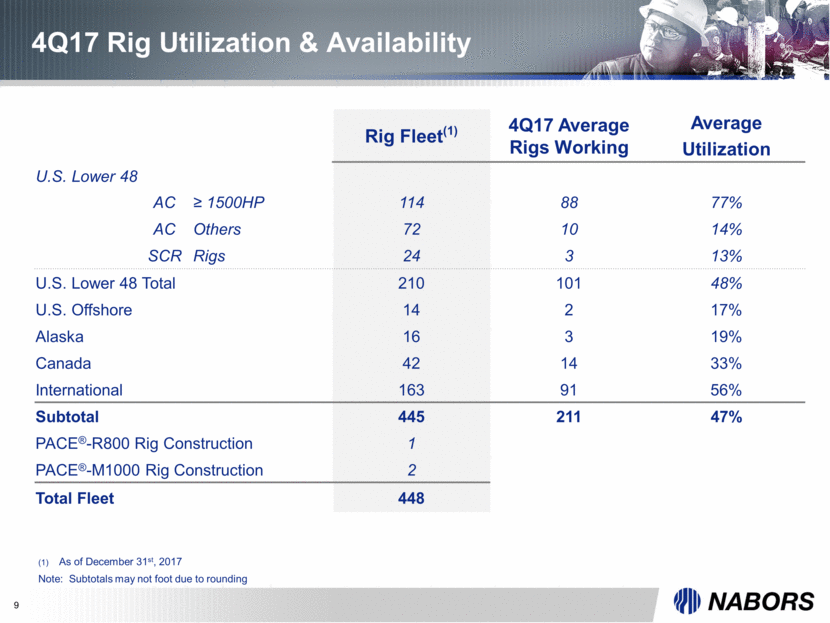
10 Walking Skidding Pad Not Pad Total Capable Capable Rigs Active Total Util. Active Total Util. Active Total Total Active Total Util. Active Total Util. AC 89 139 64% 6 20 30% 95 159 60% 5 27 19% 100 186 54% PACE X 47 47 100% 0 0 0% 47 47 100% 0 0 0% 47 47 100% PACE M800 6 6 100% 0 0 0% 6 6 100% 0 0 0% 6 6 100% PACE M1000 2 2 100% 0 0 0% 2 2 100% 0 0 0% 2 2 100% PACE B 21 29 72% 0 0 0% 21 29 72% 0 0 0% 21 29 72% PACE S 9 9 100% 2 2 100% 11 11 100% 0 0 0% 11 11 100% PACE F 0 4 0% 2 6 33% 2 10 20% 2 8 25% 4 18 22% PACE M550 3 30 10% 2 8 25% 5 38 13% 3 18 17% 8 56 14% Other AC Rigs 1 12 8% 0 4 0% 1 16 6% 0 1 0% 1 17 6% Legacy 0 3 0% 3 5 60% 3 8 38% 0 16 0% 3 24 13% Total 89 142 63% 9 25 36% 98 167 59% 5 43 12% 103 210 49% Lower 48 Rig Utilization by Type As of December 31, 2017
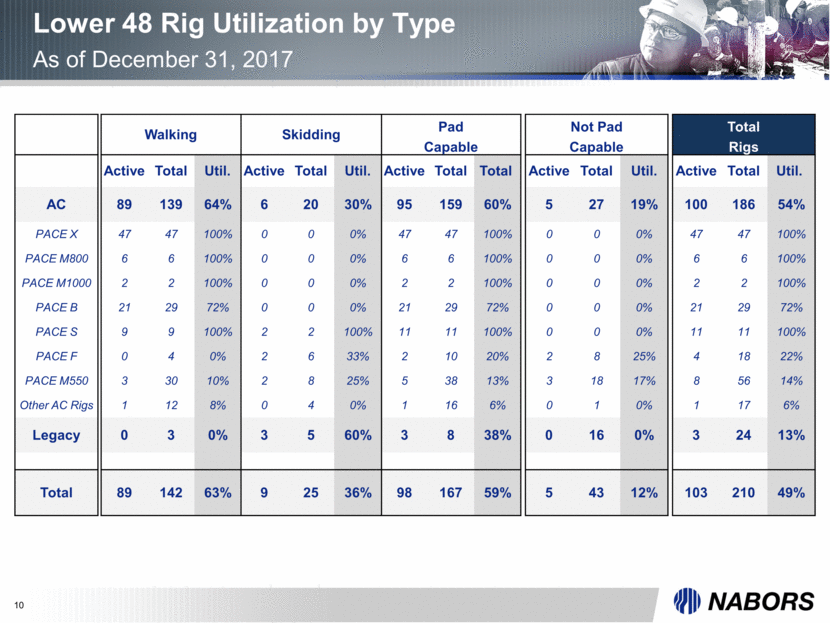
11 Nabors Drilling Operations As of December 31, 2017 Total = 216 116 US 108 Colombia 8 Algeria 4 Ecuador 1 Saudi Arabia 45 Venezuela 5 Kuwait 3 Italy 1 Argentina 15 Oman 4 India 3 UAE 1 Canada 13 Kazakhstan 3 Mexico 2 Russia 0
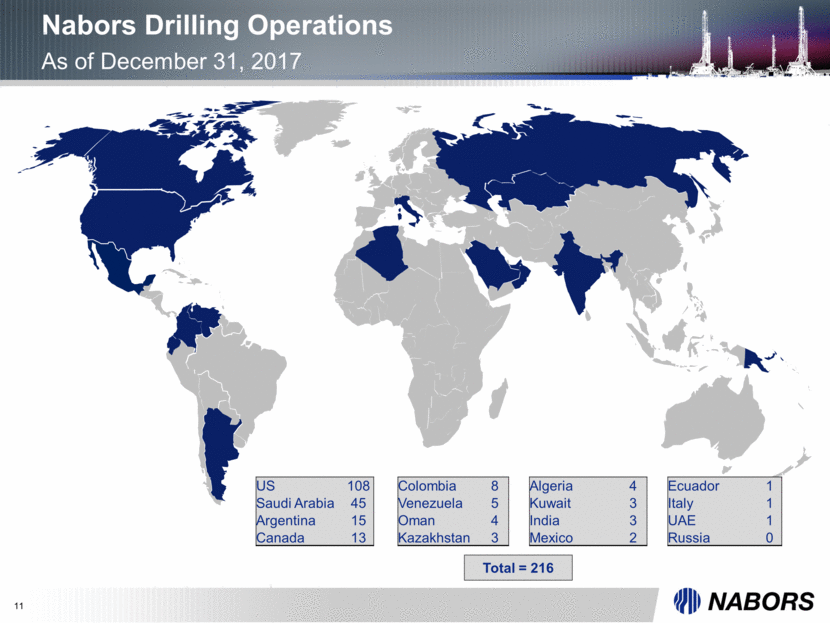
12 The New Nabors with Tesco Expanded Footprint and Doubled Patent Count NBR Only Tesco Only Both 15,300+ Employees ~1,000 New Employees 28 Active Countries 5 New Countries 450+ Patents ~Doubles Patent Count 2,600+ TDs Sold ~Doubles TD Footprint 2018 Initial Cost Synergy Target: $20mm Expected 2018 Cost Synergies: ~$25mm
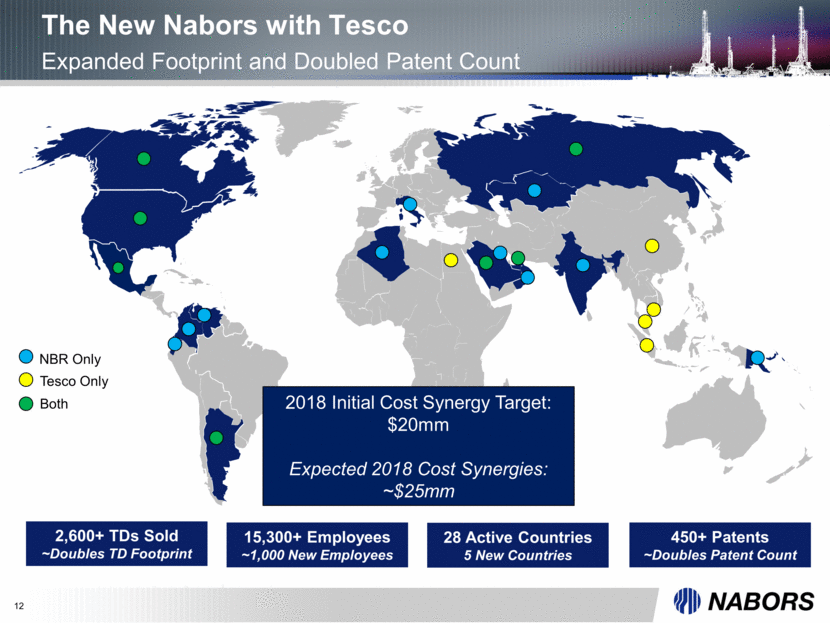
13 PACE®-M1000 - Nabors SMARTRigTM System Setting the New Gold Standard for Shale Drilling Pad Optimal Capability With Automated Walking System Side-SaddleTM Rig Configuration Hydraulic Raised Mast & Substructure Hook Load 1,000,000 lbs Setback 900,000 lbs Racking Capacity 30,000ft of 5-7/8” Drill Pipe RigtelligentTM - Integrated Operating System NDS-ReadyTM Package 1 2 3 4 5 1 2 3 4 6 6 5 7 8 7 8 All four PACE®-M1000’s now deployed with major operators, three in W. Texas, one in Eagle Ford at rates in the low-to-mid $20,000s
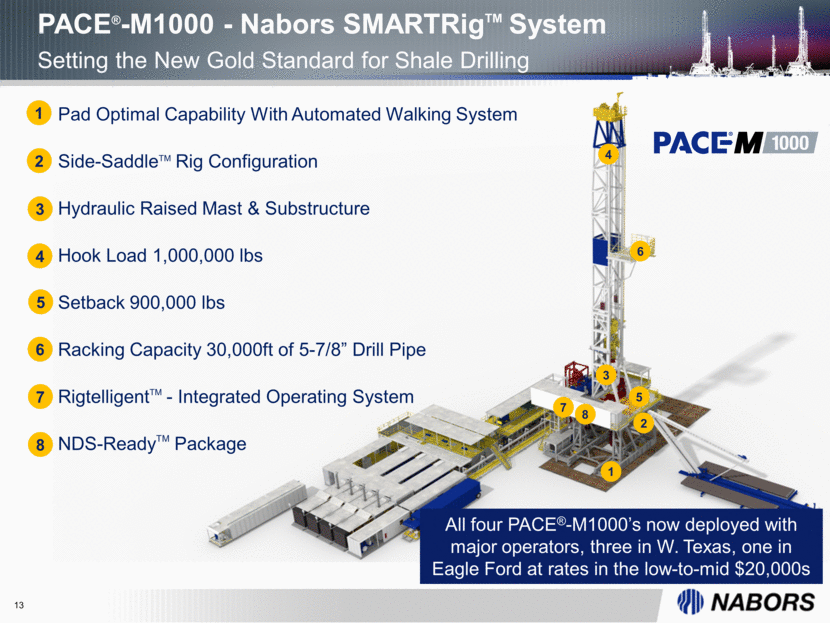
14 Appendix
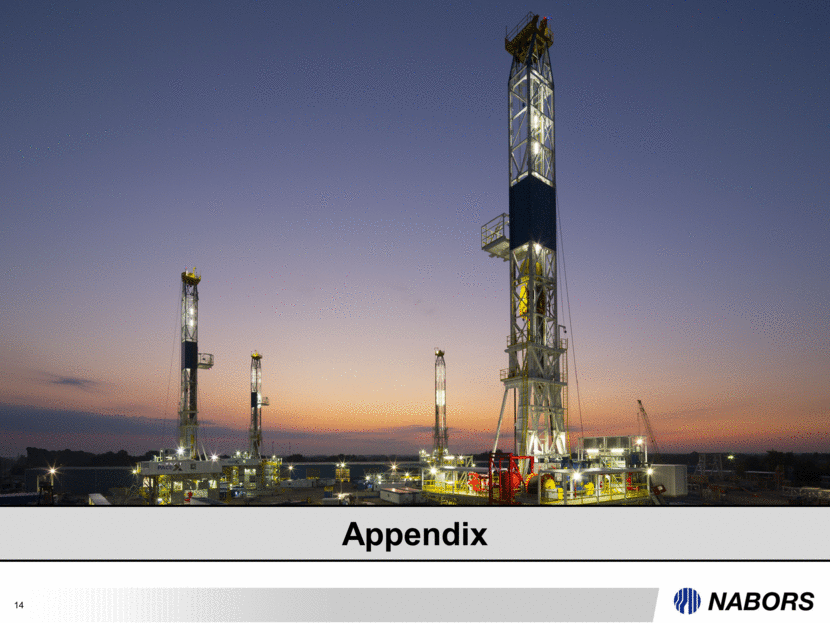
15 Rig Margins & Activity (1) Margin = gross margin per rig per day for the period. Gross margin is computed by subtracting direct costs from operating revenues for the period. 1Q17 2Q17 3Q17 4Q17 Drilling Margin(1) Avg. Rigs Working Margin(1) Avg. Rigs Working Margin(1) Avg. Rigs Working Margin(1) Avg. Rigs Working U.S. Drilling $4,484 88.8 $5,071 100.6 $5,296 107.2 $6,444 106.3 Canada 3,985 22.0 5,136 12.4 3,497 13.5 4,650 13.8 International 15,434 89.8 17,788 92.7 18,233 91.3 17,213 90.7
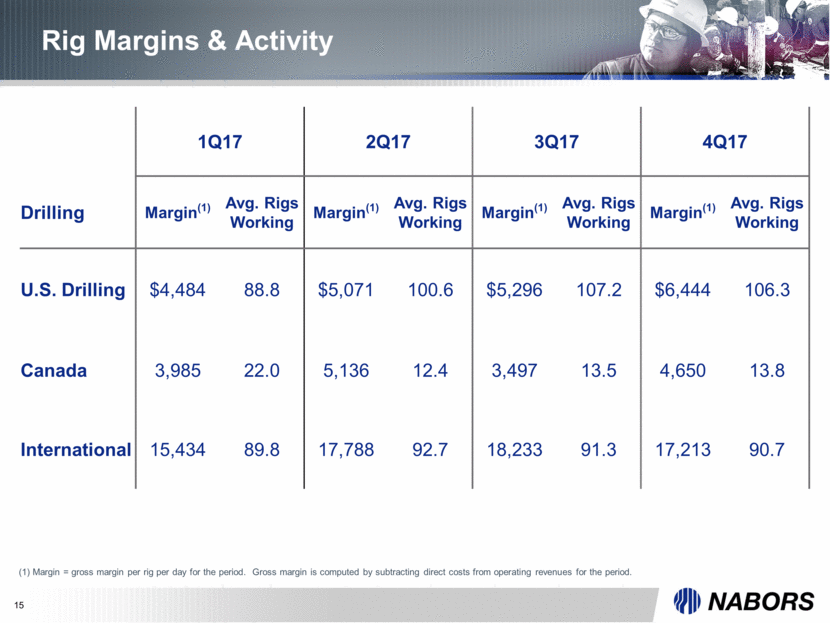
16 Reconciliation of Adjusted EBITDA to Income (Loss) from Cont. Operations Before Income Taxes Adjusted EBITDA is computed by subtracting the sum of direct costs, general and administrative expenses and research and engineering expenses from operating revenues. Adjusted operating income (loss) is computed similarly, but also subtracts depreciation and amortization expenses from operating revenues. In addition, adjusted EBITDA and adjusted operating income (loss) exclude certain cash expenses that the Company is obligated to pay. Each of these non-GAAP measures has limitations and therefore should not be used in isolation or as a substitute for the amounts reported in accordance with GAAP. However, management evaluates the performance of its operating segments and the consolidated Company based on several criteria, including adjusted EBITDA and adjusted operating income (loss), because it believes that these financial measures accurately reflect the Company’s ongoing profitability and performance. Securities analysts and investors use these measures as some of the metrics on which they analyze the Company’s performance. Other companies in this industry may compute these measures differently. A reconciliation of adjusted EBITDA and adjusted operating income (loss) to income (loss) from continuing operations before income taxes which is the nearest comparable GAAP financial measure, is provided in the table below. Three Months Ended December 31, March 31, June 30, September 30, December 31, (In Thousands) 2016 2017 2017 2017 2017 Adjusted EBITDA $146,021 $99,740 $138,796 $142,870 162,557 Depreciation and Amortization (216,187) (203,672) (208,090) (217,075) (214,106) Adjusted Operating Income (loss) (70,166) (103,932) (69,294) (74,205) (51,549) Earnings (losses) from unconsolidated affiliates 4 2 0 4 1 Investment Income (loss) 260 721 (886) 373 986 Interest Expense (47,557) (56,518) (54,688) (54,607) (57,076) Other, net (275,270) (13,510) (10,104) (5,559) (30,243) Income (loss) from continuing operations before income taxes ($392,729) ($173,237) ($134,972) ($133,994) (137,881)
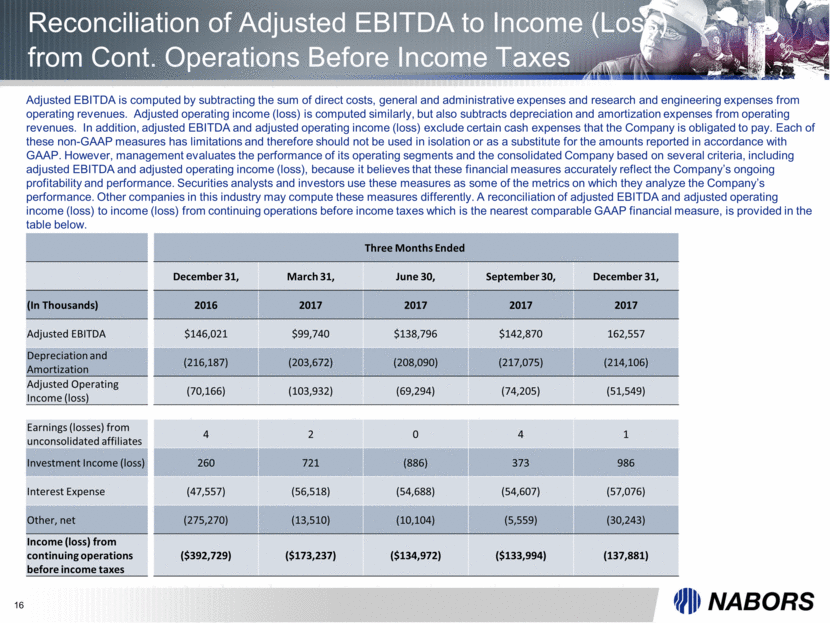
17 Reconciliation of Net Debt to Total Debt Net debt is computed by subtracting the sum of cash and short-term investments from total debt. This non-GAAP measure has limitations and therefore should not be used in isolation or as a substitute for the amounts reported in accordance with GAAP. However, management evaluates the performance of its operating segments and the consolidated Company based on several criteria, including net debt, because it believes that this financial measure accurately measures the Company’s liquidity. In addition, securities analysts and investors use this measure as one of the metrics on which they analyze the company’s performance. Other companies in this industry may compute this measure differently. A reconciliation of net debt to total debt, which is the nearest comparable GAAP financial measure, is provided in the table below. (In Thousands) March 31, 2012 December 31, 2016 September 30, 2017 December 31, 2017 Long-Term Debt $4,474,495 $3,578,335 $3,958,615 $4,027,766 Current Debt 275,616 297 196 181 Total Debt $4,750,111 $3,578,632 $3,958,811 $4,027,947 Cash & Cash Equivalents $354,022 $264,093 $190,556 $336,997 ST Investments 139,950 31,109 29,770 28,369 Net Debt $4,256,139 $3,283,430 $3,738,485 $3,662,581

